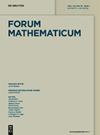求助PDF
{"title":"表面新曼数据的 \"𝐿𝑝 \"限制边界","authors":"Xianchao Wu","doi":"10.1515/forum-2024-0237","DOIUrl":null,"url":null,"abstract":"Let <jats:inline-formula> <jats:alternatives> <m:math xmlns:m=\"http://www.w3.org/1998/Math/MathML\"> <m:mrow> <m:mo stretchy=\"false\">{</m:mo> <m:msub> <m:mi>u</m:mi> <m:mi>λ</m:mi> </m:msub> <m:mo stretchy=\"false\">}</m:mo> </m:mrow> </m:math> <jats:inline-graphic xmlns:xlink=\"http://www.w3.org/1999/xlink\" xlink:href=\"graphic/j_forum-2024-0237_ineq_0001.png\"/> <jats:tex-math>\\{u_{\\lambda}\\}</jats:tex-math> </jats:alternatives> </jats:inline-formula> be a sequence of <jats:inline-formula> <jats:alternatives> <m:math xmlns:m=\"http://www.w3.org/1998/Math/MathML\"> <m:msup> <m:mi>L</m:mi> <m:mn>2</m:mn> </m:msup> </m:math> <jats:inline-graphic xmlns:xlink=\"http://www.w3.org/1999/xlink\" xlink:href=\"graphic/j_forum-2024-0237_ineq_0002.png\"/> <jats:tex-math>L^{2}</jats:tex-math> </jats:alternatives> </jats:inline-formula>-normalized Laplacian eigenfunctions on a compact two-dimensional smooth Riemanniann manifold <jats:inline-formula> <jats:alternatives> <m:math xmlns:m=\"http://www.w3.org/1998/Math/MathML\"> <m:mrow> <m:mo stretchy=\"false\">(</m:mo> <m:mi>M</m:mi> <m:mo>,</m:mo> <m:mi>g</m:mi> <m:mo stretchy=\"false\">)</m:mo> </m:mrow> </m:math> <jats:inline-graphic xmlns:xlink=\"http://www.w3.org/1999/xlink\" xlink:href=\"graphic/j_forum-2024-0237_ineq_0003.png\"/> <jats:tex-math>(M,g)</jats:tex-math> </jats:alternatives> </jats:inline-formula>. We seek to get an <jats:inline-formula> <jats:alternatives> <m:math xmlns:m=\"http://www.w3.org/1998/Math/MathML\"> <m:msup> <m:mi>L</m:mi> <m:mi>p</m:mi> </m:msup> </m:math> <jats:inline-graphic xmlns:xlink=\"http://www.w3.org/1999/xlink\" xlink:href=\"graphic/j_forum-2024-0237_ineq_0004.png\"/> <jats:tex-math>L^{p}</jats:tex-math> </jats:alternatives> </jats:inline-formula> restriction bound of the Neumann data <jats:inline-formula> <jats:alternatives> <m:math xmlns:m=\"http://www.w3.org/1998/Math/MathML\"> <m:msub> <m:mrow> <m:mrow> <m:msup> <m:mi>λ</m:mi> <m:mrow> <m:mo>−</m:mo> <m:mn>1</m:mn> </m:mrow> </m:msup> <m:mo lspace=\"0em\"></m:mo> <m:mrow> <m:msub> <m:mo rspace=\"0em\">∂</m:mo> <m:mi>ν</m:mi> </m:msub> <m:msub> <m:mi>u</m:mi> <m:mi>λ</m:mi> </m:msub> </m:mrow> </m:mrow> <m:mo stretchy=\"false\">|</m:mo> </m:mrow> <m:mi>γ</m:mi> </m:msub> </m:math> <jats:inline-graphic xmlns:xlink=\"http://www.w3.org/1999/xlink\" xlink:href=\"graphic/j_forum-2024-0237_ineq_0005.png\"/> <jats:tex-math>\\lambda^{-1}\\partial_{\\nu}u_{\\lambda}|_{\\gamma}</jats:tex-math> </jats:alternatives> </jats:inline-formula> along a unit geodesic 𝛾. Using the 𝑇-<jats:inline-formula> <jats:alternatives> <m:math xmlns:m=\"http://www.w3.org/1998/Math/MathML\"> <m:msup> <m:mi>T</m:mi> <m:mo>∗</m:mo> </m:msup> </m:math> <jats:inline-graphic xmlns:xlink=\"http://www.w3.org/1999/xlink\" xlink:href=\"graphic/j_forum-2024-0237_ineq_0006.png\"/> <jats:tex-math>T^{*}</jats:tex-math> </jats:alternatives> </jats:inline-formula> argument, one can transfer the problem to an estimate of the norm of a Fourier integral operator and show that such bound is <jats:inline-formula> <jats:alternatives> <m:math xmlns:m=\"http://www.w3.org/1998/Math/MathML\"> <m:mrow> <m:mi>O</m:mi> <m:mo></m:mo> <m:mrow> <m:mo stretchy=\"false\">(</m:mo> <m:msup> <m:mi>λ</m:mi> <m:mrow> <m:mrow> <m:mo>−</m:mo> <m:mfrac> <m:mn>1</m:mn> <m:mi>p</m:mi> </m:mfrac> </m:mrow> <m:mo>+</m:mo> <m:mfrac> <m:mn>3</m:mn> <m:mn>2</m:mn> </m:mfrac> </m:mrow> </m:msup> <m:mo stretchy=\"false\">)</m:mo> </m:mrow> </m:mrow> </m:math> <jats:inline-graphic xmlns:xlink=\"http://www.w3.org/1999/xlink\" xlink:href=\"graphic/j_forum-2024-0237_ineq_0007.png\"/> <jats:tex-math>O(\\lambda^{-\\frac{1}{p}+\\frac{3}{2}})</jats:tex-math> </jats:alternatives> </jats:inline-formula>. The stationary phase theorem plays the crucial role in our proof. Moreover, this upper bound is shown to be optimal.","PeriodicalId":12433,"journal":{"name":"Forum Mathematicum","volume":"24 1","pages":""},"PeriodicalIF":1.0000,"publicationDate":"2024-07-10","publicationTypes":"Journal Article","fieldsOfStudy":null,"isOpenAccess":false,"openAccessPdf":"","citationCount":"0","resultStr":"{\"title\":\"The 𝐿𝑝 restriction bounds for Neumann data on surface\",\"authors\":\"Xianchao Wu\",\"doi\":\"10.1515/forum-2024-0237\",\"DOIUrl\":null,\"url\":null,\"abstract\":\"Let <jats:inline-formula> <jats:alternatives> <m:math xmlns:m=\\\"http://www.w3.org/1998/Math/MathML\\\"> <m:mrow> <m:mo stretchy=\\\"false\\\">{</m:mo> <m:msub> <m:mi>u</m:mi> <m:mi>λ</m:mi> </m:msub> <m:mo stretchy=\\\"false\\\">}</m:mo> </m:mrow> </m:math> <jats:inline-graphic xmlns:xlink=\\\"http://www.w3.org/1999/xlink\\\" xlink:href=\\\"graphic/j_forum-2024-0237_ineq_0001.png\\\"/> <jats:tex-math>\\\\{u_{\\\\lambda}\\\\}</jats:tex-math> </jats:alternatives> </jats:inline-formula> be a sequence of <jats:inline-formula> <jats:alternatives> <m:math xmlns:m=\\\"http://www.w3.org/1998/Math/MathML\\\"> <m:msup> <m:mi>L</m:mi> <m:mn>2</m:mn> </m:msup> </m:math> <jats:inline-graphic xmlns:xlink=\\\"http://www.w3.org/1999/xlink\\\" xlink:href=\\\"graphic/j_forum-2024-0237_ineq_0002.png\\\"/> <jats:tex-math>L^{2}</jats:tex-math> </jats:alternatives> </jats:inline-formula>-normalized Laplacian eigenfunctions on a compact two-dimensional smooth Riemanniann manifold <jats:inline-formula> <jats:alternatives> <m:math xmlns:m=\\\"http://www.w3.org/1998/Math/MathML\\\"> <m:mrow> <m:mo stretchy=\\\"false\\\">(</m:mo> <m:mi>M</m:mi> <m:mo>,</m:mo> <m:mi>g</m:mi> <m:mo stretchy=\\\"false\\\">)</m:mo> </m:mrow> </m:math> <jats:inline-graphic xmlns:xlink=\\\"http://www.w3.org/1999/xlink\\\" xlink:href=\\\"graphic/j_forum-2024-0237_ineq_0003.png\\\"/> <jats:tex-math>(M,g)</jats:tex-math> </jats:alternatives> </jats:inline-formula>. We seek to get an <jats:inline-formula> <jats:alternatives> <m:math xmlns:m=\\\"http://www.w3.org/1998/Math/MathML\\\"> <m:msup> <m:mi>L</m:mi> <m:mi>p</m:mi> </m:msup> </m:math> <jats:inline-graphic xmlns:xlink=\\\"http://www.w3.org/1999/xlink\\\" xlink:href=\\\"graphic/j_forum-2024-0237_ineq_0004.png\\\"/> <jats:tex-math>L^{p}</jats:tex-math> </jats:alternatives> </jats:inline-formula> restriction bound of the Neumann data <jats:inline-formula> <jats:alternatives> <m:math xmlns:m=\\\"http://www.w3.org/1998/Math/MathML\\\"> <m:msub> <m:mrow> <m:mrow> <m:msup> <m:mi>λ</m:mi> <m:mrow> <m:mo>−</m:mo> <m:mn>1</m:mn> </m:mrow> </m:msup> <m:mo lspace=\\\"0em\\\"></m:mo> <m:mrow> <m:msub> <m:mo rspace=\\\"0em\\\">∂</m:mo> <m:mi>ν</m:mi> </m:msub> <m:msub> <m:mi>u</m:mi> <m:mi>λ</m:mi> </m:msub> </m:mrow> </m:mrow> <m:mo stretchy=\\\"false\\\">|</m:mo> </m:mrow> <m:mi>γ</m:mi> </m:msub> </m:math> <jats:inline-graphic xmlns:xlink=\\\"http://www.w3.org/1999/xlink\\\" xlink:href=\\\"graphic/j_forum-2024-0237_ineq_0005.png\\\"/> <jats:tex-math>\\\\lambda^{-1}\\\\partial_{\\\\nu}u_{\\\\lambda}|_{\\\\gamma}</jats:tex-math> </jats:alternatives> </jats:inline-formula> along a unit geodesic 𝛾. Using the 𝑇-<jats:inline-formula> <jats:alternatives> <m:math xmlns:m=\\\"http://www.w3.org/1998/Math/MathML\\\"> <m:msup> <m:mi>T</m:mi> <m:mo>∗</m:mo> </m:msup> </m:math> <jats:inline-graphic xmlns:xlink=\\\"http://www.w3.org/1999/xlink\\\" xlink:href=\\\"graphic/j_forum-2024-0237_ineq_0006.png\\\"/> <jats:tex-math>T^{*}</jats:tex-math> </jats:alternatives> </jats:inline-formula> argument, one can transfer the problem to an estimate of the norm of a Fourier integral operator and show that such bound is <jats:inline-formula> <jats:alternatives> <m:math xmlns:m=\\\"http://www.w3.org/1998/Math/MathML\\\"> <m:mrow> <m:mi>O</m:mi> <m:mo></m:mo> <m:mrow> <m:mo stretchy=\\\"false\\\">(</m:mo> <m:msup> <m:mi>λ</m:mi> <m:mrow> <m:mrow> <m:mo>−</m:mo> <m:mfrac> <m:mn>1</m:mn> <m:mi>p</m:mi> </m:mfrac> </m:mrow> <m:mo>+</m:mo> <m:mfrac> <m:mn>3</m:mn> <m:mn>2</m:mn> </m:mfrac> </m:mrow> </m:msup> <m:mo stretchy=\\\"false\\\">)</m:mo> </m:mrow> </m:mrow> </m:math> <jats:inline-graphic xmlns:xlink=\\\"http://www.w3.org/1999/xlink\\\" xlink:href=\\\"graphic/j_forum-2024-0237_ineq_0007.png\\\"/> <jats:tex-math>O(\\\\lambda^{-\\\\frac{1}{p}+\\\\frac{3}{2}})</jats:tex-math> </jats:alternatives> </jats:inline-formula>. The stationary phase theorem plays the crucial role in our proof. Moreover, this upper bound is shown to be optimal.\",\"PeriodicalId\":12433,\"journal\":{\"name\":\"Forum Mathematicum\",\"volume\":\"24 1\",\"pages\":\"\"},\"PeriodicalIF\":1.0000,\"publicationDate\":\"2024-07-10\",\"publicationTypes\":\"Journal Article\",\"fieldsOfStudy\":null,\"isOpenAccess\":false,\"openAccessPdf\":\"\",\"citationCount\":\"0\",\"resultStr\":null,\"platform\":\"Semanticscholar\",\"paperid\":null,\"PeriodicalName\":\"Forum Mathematicum\",\"FirstCategoryId\":\"100\",\"ListUrlMain\":\"https://doi.org/10.1515/forum-2024-0237\",\"RegionNum\":3,\"RegionCategory\":\"数学\",\"ArticlePicture\":[],\"TitleCN\":null,\"AbstractTextCN\":null,\"PMCID\":null,\"EPubDate\":\"\",\"PubModel\":\"\",\"JCR\":\"Q1\",\"JCRName\":\"MATHEMATICS\",\"Score\":null,\"Total\":0}","platform":"Semanticscholar","paperid":null,"PeriodicalName":"Forum Mathematicum","FirstCategoryId":"100","ListUrlMain":"https://doi.org/10.1515/forum-2024-0237","RegionNum":3,"RegionCategory":"数学","ArticlePicture":[],"TitleCN":null,"AbstractTextCN":null,"PMCID":null,"EPubDate":"","PubModel":"","JCR":"Q1","JCRName":"MATHEMATICS","Score":null,"Total":0}
引用次数: 0
引用
批量引用


